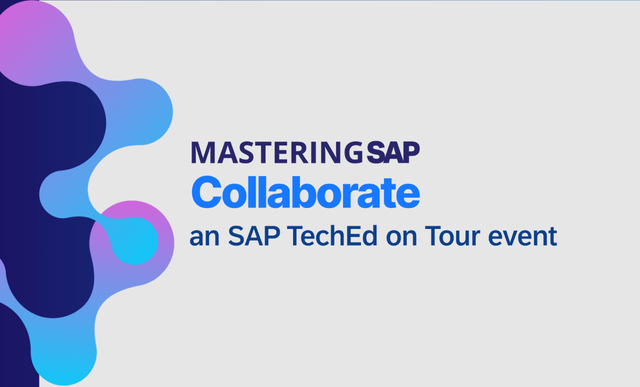SAP ABAP
Filter By
Browse By
- SAP Analytics and AI
- SAP Application Development and Integration
- All SAP Application Development and Integration
- SAP ABAP
- SAP ABAP Development Tools
- SAP ABAP Test Cockpit
- SAP API Management
- SAP BAPI
- SAP Basis
- SAP BRF
- SAP Business Application Studio
- SAP CMS
- SAP Design Studio
- SAP Development Tools
- SAP DevOps
- SAP EAI
- SAP EDI
- SAP Extension Suite
- SAP Fiori
- SAP Fiori Elements
- SAP Integration Suite
- SAP Low Code Application Development
- SAP Low Code Automation
- SAP Netweaver
- SAP Release Management
- SAP UI5
- SAP Web Application Server
- SAP Web IDE
- SAP Business Process Management
- SAP Center of Excellence
- SAP CIO
- SAP Customer Experience
- SAP Data and Data Management
- All SAP Data and Data Management
- SAP BW
- SAP BW/4HANA
- SAP Crystal Reports
- SAP Data Archiving
- SAP Data Center
- SAP Data Governance
- SAP Data Integration
- SAP Data Migration
- SAP Data Quality
- SAP Data Services
- SAP Data Strategy
- SAP Data Visualization
- SAP Data Warehouse Cloud
- SAP DMS
- SAP Document Control
- SAP EIM
- SAP ETL
- SAP ETL Tools
- SAP HANA
- SAP HANA Administration
- SAP HANA Deployment Infrastructure
- SAP HANA Studio
- SAP Master Data
- SAP Master Data Governance
- SAP MDM
- SAP Enterprise Architect
- SAP Enterprise Asset Management
- SAP ERP
- SAP Finance
- All SAP Finance
- SAP Accounting
- SAP AR AP
- SAP Asset Accounting
- SAP Billing Systems
- SAP BPC
- SAP BRIM
- SAP Cash Management
- SAP Central Finance
- SAP Controlling
- SAP COPA
- SAP Cost Center Accounting
- SAP Currency Risk
- SAP e-invoicing
- SAP FICO
- SAP Finance Automation
- SAP Advanced Financial Closing
- SAP Financial Consolidation
- SAP Financial Planning
- SAP FX Risk
- SAP General Ledger
- SAP Global Tax Management
- SAP Hyperion
- SAP Order to Cash
- SAP Payment Processing
- SAP Profitability Analysis
- SAP Rebate Management
- SAP S/4HANA Finance
- SAP SWIFT Compliance
- SAP Treasury Management
- SAP Universal Journal
- SAP Governance Risk and Compliance
- SAP Human Capital Management
- SAP Intelligent Technologies
- SAP Platform and Technology
- All SAP Platform and Technology
- SAP Business Technology Platform
- SAP Cloud
- SAP Cloud Connector
- SAP Cloud Integration Platform
- SAP Cloud Migration
- SAP Cloud Platform
- SAP Cloud Providers
- SAP Cloud Strategy
- SAP Digital Signature
- SAP Container Platform
- SAP HANA Enterprise Cloud
- SAP Digital Asset Management
- SAP Smart Forms
- SAP HEC
- SAP Digital Integration Hub
- SAP Hyperscalers
- SAP Infrastructure
- SAP Messaging
- SAP Quality and Testing
- SAP Security
- SAP Spend Management
- SAP Supply Chain Management
- All SAP Supply Chain Management
- SAP APO
- SAP Asset Management
- SAP Business Network
- SAP Digital Manufacturing Cloud
- SAP Digital Twin
- SAP EWM
- SAP IBP
- SAP Inventory Management
- SAP Label Printing
- SAP Logistics
- SAP Manufacturing
- SAP Manufacturing Automation
- SAP MES
- SAP MII
- SAP MM
- SAP MRO
- SAP MRP
- SAP Order Management
- SAP Plant Maintenance
- SAP PLM
- SAP Production Planning
- SAP S&OP
- SAP SD
- SAP SPM
- SAP Supply Chain Planning
- SAP Track and Trace
- SAP Transportation Management
- SAP System Administration
What Is SAP ABAP?
The SAP ABAP programming language allows organizations to process large amounts of data within SAP business solutions. Having a working knowledge of SAP ABAP code enables customization within a system, offering greater control over essential business functions. It is supported on the SAP NetWeaver ABAP application server platform.
What Is SAP ABAP?
The SAP ABAP programming language allows organizations to process large amounts of data within SAP business solutions. Having a working knowledge of SAP ABAP code enables customization within a system, offering greater control over essential business functions. It is supported on the SAP NetWeaver ABAP application server platform.
Predictions about the death of ABAP (Advanced Business Application Programming), SAP’s four-decade old programming language, have continually failed. ABAP has evolved to stay relevant through the waves of change such as object-oriented programming, Java, Webdynpro, SAP HANA, SAP Fiori, and cloud applications. With large SAP customers continuing to use ABAP, a new generation of programmers continue to join the passionate, senior cohorts of ABAP programmers.
History and Evolution
ABAP is a fourth-generation programming language that was introduced by SAP in the 1980s. It was created for the development and customization of SAP software. For many decades, it was the only language that could be used to customize or develop SAP software components. ABAP is a multi-paradigm programming language, meaning programmers can utilize procedural, object-oriented, and other programming principles. Programs written with ABAP can run alongside those based on other languages such as Java, JavaScript, and SAPUI5. ABAP has continued to thrive even as SAP acquired non-ABAP solutions. SAP has released ABAP on the cloud, enabling the extensibility of SAP solutions to the cloud. Now, ABAP is used to develop applications for SAP Fiori, SAP S/4HANA, SAP Business Technology Platform, etc.
Should You learn SAP ABAP?
Developing technical skills in SAP ABAP allows you to modify virtually all SAP solutions and even create web applications. SAP provides its users with an ABAP Learning Journey via SAP Press in the form of books, blog posts, and videos. These tips and tricks can help you hone work processes in SAP ABAP to maximize the effectiveness of your SAP landscape.
All SAP solutions up through SAP S/4HANA can be modified with ABAP code. This means that mastering ABAP gives you the capability to develop and modify reports, interfaces, forms, data conversations, and much more. Learning SAP ABAP gives users the technical ability and skills to master their SAP environment. It is the technology that underpins SAP’s traditional Business Suite, the flagship solution SAP S/4HANA, and many others. In a competitive business environment, it is vital for organizations to have talent with fluency in SAP ABAP.
SAP says its ABAP programming language runs in over 100,000 customer systems, offering users enterprise-ready business applications that can help reduce costs as it is already integrated with SAP. With a reported 4.5 million registered ABAP developers, it is essential to have access to the innovation capabilities that SAP ABAP provides.
SAP ABAP combines SAP’s in-memory database SAP HANA with the digital user experience through SAP Fiori. This technology is consistently updated and extended to maximize its utility and functionality for added application development capabilities and new business scenarios.
How ABAP Works
As a multi-paradigm programming language, SAP ABAP allows programmers to use both procedural and object-oriented principles. This allows programmers to follow the programming model that works the best for them and for their project as well.
Each ABAP program operates within the ABAP Runtime environment, which processes statements and handles events and the flow logic of screens. Though it is SAP’s primary programming language, some applications that SAP acquired may not fully run on ABAP in SAP. However, these products will still come into contact with ABAP when they interface with a central ABAP-based system like an SAP ERP.
Since its release in the 1980s, SAP ABAP has consistently changed and evolved to best meet the needs of SAP users and organizations. To that end, SAP provides users with a set of tools and programs known as the ABAP Workbench. This development environment allows users to test, develop, and execute new programs within SAP, as well as edit existing ABAP programs, write report programs, function modules, and module pools.
This functionality helps programmers create a simple graphical user interface, handle the complete ABAP application development lifecycle, communicate between desktop applications, and access all programming objects. As it is feature-driven, the execution of apps will be affected by user actions and system events.
Before users can start working on their business processes and applications, the SAP database must first be filled. There are a handful of different methods to transfer data into the system. These methods should be weighed based on both the volume and the complexity of the data at hand that is set to be moved over. Data can also be transferred between SAP systems or from a non-SAP system to an SAP system that relies on the SAP ABAP language.
SAP ABAP also offers users different options for writing general programming, using the capabilities of the R/3 system. Users can either execute programs online or, if they would prefer, those programs can also be executed in the background. Users may opt for jobs that run in the background so they can be scheduled at different intervals.
Looking Ahead
SAP made a big move in releasing ABAP for the cloud to ease the migration and maintenance of existing applications to the cloud via the ABAP environment in the SAP Business Technology Platform. ABAP developers can now leverage their seasoned expertise on the cloud with only some training in the ABAP RESTful application programming model. They can do this despite some substantial differences between the new and old ABAP. The most popular use of ABAP for the cloud is adding custom functionality to SAP S/4HANA installation on the cloud. There are restrictions on this capability, with ABAP cloud applications only having limited access to data in the core SAP S/4HANA through a set of OData services.
Clients can be opportunistic in their application development and integration strategy with ABAP, along with other options such as Java, Python, node.js, HTML5, etc., based on their software portfolio, developers’ skillsets, and specific use cases. In addition, SAP customers with complicated customizations are now aiming for a clean core. Modern approaches allow for decoupling customizations from the core business systems with cloud extensions. Clients also aim for clear separations between SAP and third-party extensions.
In summary, ABAP can continue to play a major role in the application strategy. However, organizations must invest in upskilling and select the programming model that suits them best. They must also aim for a clean core to deliver nimble and rapid applications that impact the business.
Join SAPinsider to access opportunities for networking and engagement in the dynamic SAP ecosystem. As a member, you will have access to a wealth of valuable resources and content tailored to SAP technologies and best practices like the latest research reports, articles, webinars, and events that will keep you informed and ahead of the curve.
SAPinsider membership grants you exclusive access to in-depth analyses, expert insights, and practical guidance that will empower you to navigate the ever-evolving SAP landscape with ease. SAPinsider membership will enable you to remain one step ahead and harness the latest trends, innovations, and strategies to drive your own powerful digital transformations, optimize your SAP investments, and unlock business success.
499 results
-

 Premium
Premium
Ask the HR Expert: How Do I Use Processing Classes in SAP Payroll?
Reading time: 8 mins
Explore how your Payroll system uses processing classes. Our HR expert offers helpful hints and tips and explains how to create your own processing classes. Key Concept Dear HR Expert, I have worked in SAP HR Payroll/Time for a couple of years, but I still do not completely understand the concept of processing classes in...…
-

 Premium
Premium
Improve Your Data-Entry Efficiency and Accuracy with Defaults
Reading time: 21 mins
The integrity of your master data is vital to your business. Manual data entry is often the source of errors in master data. To minimize incorrect information in your system, you can use standard functionality to default commonly used master data values and processes. Key Concept The 4.6C system has more than 4,000 user parameters....…
-

 Premium
Premium
Indirect Valuation Modules: Customize Your Wage Calculations
Reading time: 25 mins
R/3 provides a variety of indirect valuation modules for determining the entry amounts for wage types. However, in many scenarios, the existing modules may not suffice and you may need to create your own. Moreover, these computed entry amounts are not stored in the same manner as other fields of an infotype. The handling of...…
-
-

 Premium
Premium
Performance Problems in ABAP Programs: How to Fix Them
Reading time: 2 mins
Whatever the cause of your program’s performance troubles, optimizing the runtime of the application requires that you first find out where the majority of the runtime is spent. The first installment of this two-part article series showed you how to use SAP’s performance monitoring and tracing tools to identify the critical actions or code sequences...…
-

 Premium
Premium
How to Eliminate Duplicate Line Reporting
Reading time: 10 mins
Many businesses encounter the problem of duplicate line reporting in Ad Hoc or SAP Query. Our HR Expert explains why this occurs and how it relates to the date parameter setting. She then provides three different methods to achieve single-line reporting. Key Concept Dear HR Expert, I have read a lot of the documentation in...…
-

 Premium
Premium
Effectively Manage the Talent Life Cycle with SAP ERP HCM: Part 2
Reading time: 20 mins
Learn about the design of jobs in SAP ERP HCM and the importance of considering your qualifications needs in this design process. Find out more about the use of job and employee profiles in SAP and how they function within the talent management life cycle. Key Concept By relating qualifications to jobs, positions, and persons,...…
-

 Premium
Premium
Control Cross-Company Accounting in SAP Payroll
Reading time: 35 mins
R/3’s Payroll functionality allows you to charge payroll costs from one company code to another. However, it does not always work the way you want it to. You may be unable to charge a cost to another code or an unwanted charge could appear on your company code. You can create a function module that...…
-
-

 Premium
Premium
Take Full Advantage of SAP Business Workflow in SAP Access Control 10.0
Reading time: 16 mins
SAP Access Control 10.0 uses the standard SAP Business Workflow for all approval processes in the application, including user access requests. This very robust workflow engine supports more flexible multitiered routing and approval matrices. At the same time, workflow configuration in version 10.0 is one of the areas that underwent significant change and therefore requires...…
-

 Premium
Premium
Automate Period-Based Payments in the SAP Payroll System
Reading time: 12 mins
Learn how to use standard SAP payroll functionality to automate your business policies on the basis of monthly payroll periods. Key Concept Restricting execution of personnel calculation rules based on payroll periods is made easy by using standard SAP payroll operations. By employing this methodology, you can automate business policies based on payroll period constraints....…
-

- SAP Payroll
 Premium
Premium
Learn New Methods For Comparing Payroll Results and Improve Your Payroll Implementation Projects
Reading time: 11 mins
Get tips and ideas for how to perform a payroll parallel run. A payroll parallel run is the comparison of payroll results between a legacy payroll system and a new SAP payroll system that is being implemented. The results are compared line by line and wage type by wage type between the two systems. Key...…
Become a Member
Unlimited access to thousands of resources for SAP-specific expertise that can only be found here.
Become a Partner
Access exclusive SAP insights, expert marketing strategies, and high-value services including research reports, webinars, and buyers' guides, all designed to boost your campaign ROI by up to 50% within the SAP ecosystem.
Upcoming Events
-

Mastering SAP Collaborate, an SAP TechEd on Tour event
November 12 - 14, 2025
Sydney, New South Wales
Australia
View Event
Related Vendors
Your request has been successfully sent

